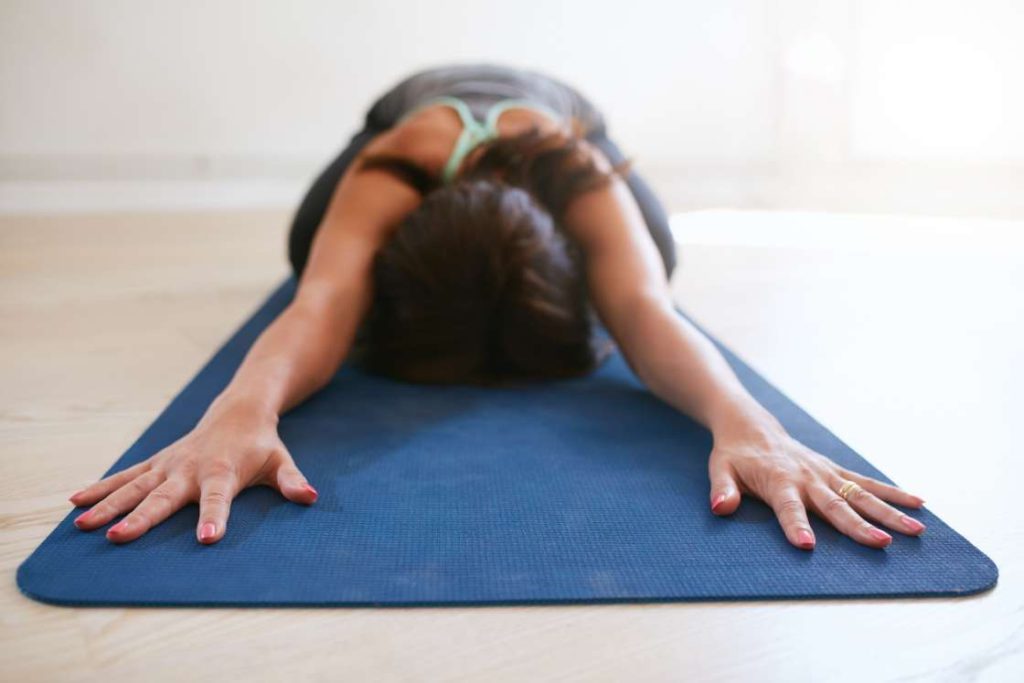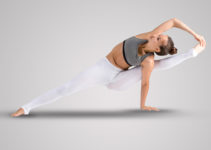- Yoga & High Blood Pressure
- Yoga poses for High BP
- Modified Bridge Pose
- Child Pose
- Easy Pose
- Reclined Hero Pose
- Bound Angle Pose
- Corpse Pose
- Poses to Avoid

If you have blood pressure with a Systolic count within 120 mm Hg and diastolic count within 80 mm Hg, then you have normal blood pressure. If your systolic count is between 120-140 mm Hg and your diastolic count is between 80-90 mm Hg your blood pressure is on the rise. With a systolic count over 140 mm Hg and diastolic count over 90 mm Hg, you will be considered hypertensive.
Yoga is one of the most effective alternatives in managing high blood pressure. Like the comprehensiveness of the problem itself, yoga promotes a comprehensive chain of health benefits within your body, that lowers your blood pressure.
What Causes High Blood Pressure and How Yoga Lowers It?
The causes of high blood pressure can vary a great deal. It can be caused by diseases like kidney disorders and diabetes, nervous malfunctions, stress, narrowing of the arteries, overweight, sleep disorders, poor nutrition, and hormonal imbalance. A hypertensive will find multiple benefits from yoga including:
- Stress relief. In stress, blood pressure rises because certain muscles start producing excess (or less) hormones, and certain nerves unable to transmit proper signals. Practicing yoga lowers blood pressure beautifully by stretching those muscles, trains the nerves for better signaling, and optimizes the production of hormones.
- Balances weight. Obesity leads to high blood pressure. Yoga poses specifically target areas of your body with extra fat deposits, and trigger fat burning in those areas. Which eventually gives relief from high BP.
- Manages thyroid hormone. The thyroid can also lead to high BP. Yoga poses for thyroid hormone regulate thyroid production in your body, which reduces hypertension.
- Regulate Adrenal glands. Yoga poses like legs up the wall, bridge pose, and cobra pose can effectively help you regulate the balance of hormonal production in your adrenal glands, which in turn control blood pressure.
However, there are other means also by which yoga controls the blood pressure including your blood velocity, resistance in your Arteries, and impact on blood viscosity,
6 Yoga Poses for High Blood Pressure
Yoga poses benefit the condition of high blood pressure in multiple ways.
Firstly, yoga with its poses trains your cardiovascular muscles for better functioning. Secondly, the poses bring stability to your circulatory system. Thirdly, yoga does very effective stress management; an important benefit in high blood pressure. And finally, yoga can also help you regain your ideal BMI; obesity is often a cause of high blood pressure.
Practice these yoga poses to reduce your BP.
1. Modified Bridge Pose

Bridge pose is a very rejuvenating and relaxing pose with a wide range of cardiovascular benefits. Bridge pose pushes and stretches your cardiovascular muscles from the back, which enhances their flexibility and strength. This process also clears out blockages and regulates blood circulation. This pose, however, requires a fair bit of effort -especially putting a lot of stress on your shoulders, neck, and upper back, Which is why for high blood pressure it is wise to opt for a modified variant.
- Use a bolster for this pose. Make sure the bolster is significantly bigger than your upper body
- Sit on one end of the bolster and strap your thighs together.
- Bend your knees and let your heels touch the ground.
- Lie back on the bolster. Push against the floor with your feet, to move up the bolster so that your shoulders touch the floor. Let your head too, rest on the floor at the same level as your shoulders.
- Let your arms extend and lie on the floor by the sides of the bolster.
- Extend out your shoulders, broaden your chest and point out your toes.
- Relax your body, close your eyes and gaze towards your chest.
- Stay in this pose for 5-10 minutes. 10 minutes, only if comfortable.
Make sure to choose the bolster of right depth, width and length. The length should be from above your knees to just below your shoulder blades. The width should be as much as your shoulders and the depth just enough for your shoulders to hang out and touch the floor.
2. Child Pose – Balasana

Balasana or Child pose is yet another easy one that relaxes your body, manages your stress, and regulates your blood pressure. Balasana increases blood flow to the lower abdomen and helps digestive and metabolic activities as well. You can practice this asana post-meal for better digestive benefits. Obesity is yet another issue that balasana can help you with.
- Kneel on the floor on your knees. Join your thighs and your knees. Stretch out your toes, with your big toes touching each other.
- Keep your head, back and spine straight. Open your shoulder blades.
- Keeping your upper body straight, lean forward and sit on your heels like in Vajrasana
- Stretch and pull your upper body forward and bend down.
- Go down all the way till your chest touches your knees and your forehead touches the floor.
- Extend out your hands Infront, over your head. With your palm touching the floor, try to extend as much as possible.
- Hold this pose for around 30 seconds.
Avoid this pose if you have diarrhea. Also put a blanket roll or a yoga block between your feet, and use it to sit on instead of your heels. This is highly recommended in overweight.
3. Easy Pose – Sukhasana

Sukhasana focuses mainly on controlling your breathing and calming your brain and nerves. Regular practicing of controlled breathing brings stability to the blood circulation in your cardiovascular region and your whole body in general. Sukhasana will also develop the posture of your upper body and increase your body awareness. Sukhasana aims to establish a state in your mind and body, where you are alert and relaxed at the same time.
- Sit in a comfortable cross-legged position, with your spine, back and head straight. Keep your hands on your knees.
- Breathe systematically -keep a balance between deep and light breathing.
- Make small adjustments in your sitting bones, and figure out a way to evenly distribute your weight.
- Try to relax your legs completely, yet hold up your upper body straight.
- Sit in this position for 15 minutes.
If you have back or lower back pain, do practice this pose with your back to the wall. If you have hip pain then sit on a folded blanket. And for knee pain, put a rolled blanket under your outer shin bone.
4. Modified Reclining Hero Pose – Virasana

This variation of Virasana is better suited for someone with high blood pressure -especially, because of the way it stretches the cardiovascular muscles. Virasana puts a stretch on your neck, shoulders, spine, torso, hip, abdomen, pelvic floor, thigh, knee, and ankle. In short, it benefits almost your entire body. Despite, the wide range of stretches and benefits -the execution of the pose isn’t all that difficult.
- You will need two yoga bolsters for this pose.
- First, kneel on your knees on the floor. Join your thighs and knees, and keep your entire upper body straight.
- Lean forward and sit between your feet, like in Virasana.
- Carefully, have two bolsters placed in advance, one top of another -right where your feet end. The top bolster should be smaller than the bottom bolster.
- Now slowly recline back on the bolsters.
- As you recline, ensure your lower back arches over the end of the bottom bolster -and your shoulders rest on it.
- Extend your arms out on both sides and rest your head on the top bolster.
- Close your eyes and relax in this pose for 30 seconds to 1 minute.
Like any other bolster oriented modified poses, ensure to have the bolsters of right length, width and depth that will properly support your body. You will have to excuse this pose if you have a serious back, hip or pelvic floor injury. If you have stiff groins, you can try putting weights like sandbags on your upper thighs. You can also strap together the middle part of your thighs for better support on the recline .
5. Bound Angle Pose – Baddha Konasana

Bound angle pose is a highly recommended pose for people with high blood pressure. Primarily this pose works deep into the hip, groin, and pelvic floor. But, the erect spine posture with wide stretched and open groin has other benefits as well. The posture optimizes hormonal activities, blood circulation and reduces stress -which in turn, leaves quite an impression on blood pressure.
- Sit on your sitting bones, in a staff pose, with your legs straight and stretched Infront. Heels pressing against the floor, and toes pointing towards the ceiling. Your legs should be joined from thighs to feet.
- Keep your spine as straight as possible, take support by pressing your hands against the floor, to straighten your back.
- Now bend your knees, while keeping your feet joined and planted on the floor.
- Bring your feet closer to your pelvic region, whilst separating your knees.
- Let your knees gradually fall on either sides. And, the soles of your feet coming together.
- With the soles joined, draw your feet closer to your groin and try to touch the groin with your heels.
- Clasp your toes together with your hands.
- Keep your head straight, look front and press your shoulder blades against your upper back.
- Hold the pose for 10 to 15 minutes.
Note: you can gradually lean forward to deepen the pose in your upper thighs. Or, put yoga blocks or rolled blankets under your knees to put less stress on your knees.
6. Corpse Pose – Shavasana

Shavasana is the ultimate calming, relaxing, and stress-reducing pose in yoga. Shavasana is a simple pose, but it can have a very holistic effect if practiced properly. Shavasana can enhance your blood circulation, nervous functions, metabolism, and hormone secretion. The corpse pose is something, that one might call a physical meditation.
- Lie straight on your back, on the floor.
- Press down your head, shoulders, hip, legs and feet.
- Roll out your shoulder blades from underneath your back and stretch them out, along with your hands -by your sides.
- Close your eyes and with a steady breathing, focus on each part of your body and it’s muscles.
- Now try and relax muscle by muscle, till your entire body unanimously reaches a state of relaxation.
In this pose the practitioner is required to make conscious effort to relax every muscle and organ in the body. This pose can look very minimalist on the surface, but in its subtleties -it holds a whole different dimension of its own. Which is why, perfecting this pose needs extensive practicing and patience.
Yoga poses to avoid when high blood pressure
It is important to note that certain yoga poses can do more harm than good in case of high blood pressure. Avoid the following common yoga poses if you have high blood pressure.
- Downward facing dog / Adho Mukha Svanasana
- Bow pose / Dhanurasana
- Camel Pose / Urstrasana
- Extended side angle pose / Utthita Parsvakonasana
- Shoulder stand / Sarvangasana
- Wheel pose / chakrasana
- Fish pose / Matsyasana
- Sage’s pose / Mariachi’s pose




